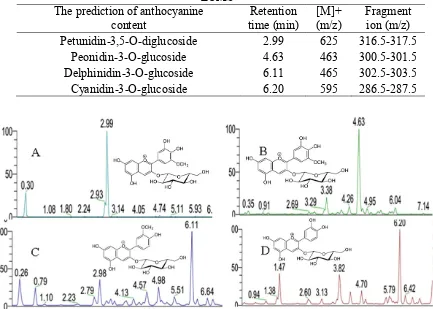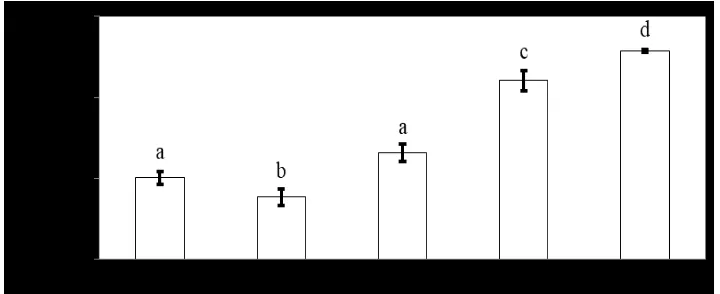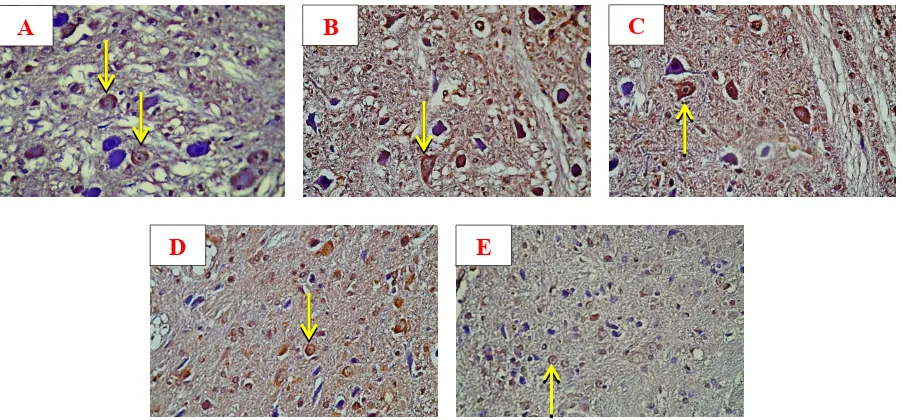The journal homepage www.jpacr.ub.ac.id p-ISSN : 2302 – 4690 | e-ISSN : 2541 – 0733
Potential of Purple Sweet Potato (
Ipomoea batatas L
) To Increase
BDNF Level and VEGF Expression in The Cerebellum of
Ischemic Stroke Rats
Eny Rahmawati1, Sasangka Prasetyawan1, Chanif Mahdi1, Arie Srihardyastutie1, Made Oka Adnyana2,
Aulanni’am Aulanni’am1,3 *
*
Corresponding email : aulani@ub.ac.id; aulani.fkhub@gmail.com
Received 18 August 2017; Revised 4 January 2018; Accepted 5 January 2018
ABSTRACT
This paper reports the effect of anthocyanin from purple sweet potato in the cerebellum of ischemic stroke rats model by Middle Cerebral Artery Occlusion (MCAO) technique. This technique was carried out by ligating the blood flow in External Carotid Artery (ECA), Common Carotid Artery (CCA) and Internal Carotid Artery (ICA) for 3 hours, followed by reperfusion. The MCAO technique proved a technique for preparing ischemic stroke rats. This technique induces releasing of Brain-Derived Nuclear Factor (BDNF) and Vascular Endothelial Growth Factor (VEGF) in the cerebellum of ischemic stroke rats. The levels of BDNF measured by ELISA technique and VEGF expression used immunohistochemistry technique. The results showed that anthocyanin from purple sweet potato increases the level of both BDNF and VEGF expression in the cerebellum of ischemic stroke rats. It is suggested that anthocyanin could be used as a therapeutic agent for ischemic stroke.
Key word: purple sweet potato, BDNF, VEGF, MCAO, ischemic stroke, cerebellum
INTRODUCTION
Ischemic stroke is caused by partial or complete occlusion of the cerebral artery which activating ischemic cascade[11]. This process induces cytotoxicity, activation of inflammation response, oxidative damage and ionic imbalance. These processes induce neuron damaging. In contrast, the hypoxia caused by blood flow blocking triggers a protein stress to form Heat Shock Protein-90 (HSP-90)[12]. This protein stimulates BDNF activation through activation of protein kinase B and Adenine Monophosphate-Activated Protein Kinase (AMPK)/ERK[13]. The formation of Brain-Derived Nuclear Factor (BDNF) is started with modification of phosphorylation protein component at synapses which modify a translation activity in the transcription process. It is also a protective sign of the brain that sprouting, growth, survival, and differentiation of neuronal structure and synapses after ischemic stroke [14]. Besides that, hypoxia stimulates producing Hypoxia-Inducible Factor-1 alpha (HIF-1α); a protein that responsible for VEGF expression. VEGF itself is a mediator of angiogenesis activated Phosphoinositide 3-Kinase (PI3K)/Akt and Mitogen-Activated Protein Kinase (MAPK) signaling pathways. Both pathways play a role in survival, proliferation, and migration of endothelial cells microvascular[15]. VEGF which bind to a receptor in endothelial cell surface stimulate angiogenesis responses, in addition, to activate, proliferate, migrate, and survive of neurons [16]. However, the increase of VEGF expression itself is the key to a protective effect in neuron damaging.
This research is focused on the cerebellum. This region does not affect directly with ischemic stroke rats induced by MCAO but it is known that the function of the human body depends on the interaction of all organs, and brain damage resulting from a stroke can lead to multiple organ failures especially in cerebellum brain area[12]. The correlation between MCAO and cerebellum was not fully understood. Thus, this paper aimed to report the differences in BDNF levels and VEGF expression in the cerebellum of ischemic stroke rats.
EXPERIMENT
Chemicals and instrumentation
The sample of purple sweet potato used in this experiment were brought from a commercial product (Sweet IMO) harvested from Bali. The chemicals used are ketamine, xylazine, PBS pH 7, PBS-Tween : PMSF, Tris-HCl, hydrogen peroxide 1 %, primer antibody of anti VEGF, secondary antibody anti-rat labeled streptavidin-biotin, SA-HRP, Meyer hematoxylin Eosin, water and Elisa Kit Rat BDNF from Elabscience Biotechnology Co., Ltd (Wuhan, Hubei Province, China) Catalog No: E-EL-R1235.
Instrumentation used for analysis the purple sweet potato beverage was UHPLC ACCELL type 1250 (Thermo Scientific). This instrumentation is equipped with an electrospray ionization (ESI) with the positive mode. A sample of purple sweet potato was injected into column equilibrated in 95:5 A: B. A= 0.1 % formic acid in water; B= 0.1 % formic acid in acetonitrile and flow rate = 300 µl/min.
LC-MS analysis
The anthocyanins in purple sweet potatoes (Ipomoea batatas) was separated and identified the structure by LC-MS/MS.
Preparation of experimental animals
provided with free access to food and water. All condition and handling conducted based on ethical protocols approved by Brawijaya University Animal Ethics Committee No. 651-KEP-UB. In this experiment, all animals were divided into 5 groups. The first was a control group (KN). The second was a group of 1 h ischemic stroke (K1). The third was a group of 72 h ischemic stroke. The fourth was a therapy group of 24 h ischemic stroke (T1) and the last was a therapy group of 72 h ischemic stroke. The therapy used purple sweet potatoes was given 2 mL by oral each day.
Middle cerebral artery occlusion (MCAO) technique
The ligation of the middle cerebral artery was conducted based on the conventional method with slight modification[17].This method was done by ligating the brain artery in the Common Carotid Artery (CCA), External Carotid Artery (ECA) and Internal Carotid Artery (ICA). The occlusion was done for 3 h. After 3 h, the ligation was released for reperfusion. As a result of ischemic reperfusion, the ischemic stroke will occur caused by lack of oxygen and glucose to the brain.
Isolations of cerebellum protein
The cerebellum was mixed and added with PBS-Tween: PMSF. The mixture was homogenized, sonicated and centrifuged. The homogenate was added with ethanol absolute and left overnight. The supernatant was centrifugated for 15 min at 10.000 rpm. The sample was taken and dried. The precipitate was mixed with Tris-HCl pH 6,8 with the ratio 1:1 (w/v)[18].
BDNF levels
The levels of BDNF were determined using Rat BDNF Elisa Kit (Elabscience Biotechnology Co, Ltd, Guangdong Science, and Technology, China) based on manufacturer instructions. All the cerebellum of rat tissues was prepared for the analysis. The cerebellum was isolated and prepared for Elisa Kit test. 100 µL of standard, blank and sample were added per-well, then were incubated for 90 minutes at 37 °C. The liquid has removed the liquid and 100 µL of biotinylated detection Ab was added and was incubated for 1 hour at 37 °C. The mixture was aspirated and washed three times with 100 µL wash buffer. Next, 100 µL of HRP conjugate was added to the mixture, and this was incubated for 30 minutes at 37 °C. This solution was aspirated and washed again wash buffer. A 90 µL of substrate solution was added to the solution and incubated for 15 minutes at 37 °C. In order to stop the reaction, 50 µL stop solution was added. The optical density of the sample solution was determined using microplate reader at a wavelength of 450 nm. The amount of BDNF was calculated from the standard calibration curve.
Immunohistochemistry of VEGF
hematoxylin-eosin. The slides were covered and observed using a microscope with magnificent 400X.
RESULT AND DISCUSSION
Figure 1 shows the LC-MS chromatogram of purple sweet potato beverages. The data shows purple sweet potato beverages contain high anthocyanin. The anthocyanins predicted are petunidin, cyanidin, and malvidin derivatives. Anthocyanins are known to be an antioxidant as the free radical scavenger and give an electron to stabilize the activity of free radicals [19]. Thus, the purple sweet potato beverages can use as therapeutic in stroke ischemic treatment.
Table 1. Prediction of anthocyanins structure in purple sweet potatoes beverages using LCMS
The prediction of anthocyanine content
Retention time (min)
[M]+ (m/z)
Fragment ion (m/z) Petunidin-3,5-O-diglucoside 2.99 625 316.5-317.5
Peonidin-3-O-glucoside 4.63 463 300.5-301.5 Delphinidin-3-O-glucoside 6.11 465 302.5-303.5 Cyanidin-3-O-glucoside 6.20 595 286.5-287.5
Figure 1. LCMS chromatogram of anthocyanins in purple sweet potato beverages. A show of Petunidin-3,5-O-glucoside B shows peonidin-glucoside. C shows delphinidin
3-O-glucoside. D shows cyanidin-3-O-3-O-glucoside.
The BDNF levels after anthocyanin therapy on Ischemic stroke
naturally[20]. Anthocyanin therapy significantly increases (p<0.05) BNDF levels in the cerebellum in ischemic stroke rats. This data suggests that reperfusion ischemic induction resulting in ischemic stroke.
There were significant differences between control group and therapy group in the cerebellum rats with an ischemic stroke. Therapy group shows a significant effect on BDNF concentrations in the cerebellum. The therapeutic group at 24 hours and 72 hours showed elevated BDNF levels to 187.84 % and 326.05 %, respectively. These changes indicate a neuroprotective ability induced by the antioxidant activity that anthocyanin possesses from purple sweet potato. Figure 2 shows a change in BDNF levels in the cerebellum of ischemic stroke rats.
Figure 2. Graph of BDNF levels in the cerebellum in an ischemic stroke rats.
The BDNF levels in areas with undifferentiated caused by reperfusion ischemia will increase BDNF expression. This is because BDNF can be produced by both neurons and non-neuron cells. In vitro studies demonstrate the ability of microglial cells, cerebral endothelial cells and astrocytes to express and secrete BDNF when the brain is exposed to ischemic conditions[21]. BDNF may improve neurogenesis after ischemic injury by activating neural and pro-neurogenic pathways PI3K/Akt and MAPK[13].
The anthocyanins contained in the purple sweet potato have the potential as neuroprotective agents to be used to treat ischemic stroke. Neuroprotective action acts in the increase of phosphatidylcholine synthesis, stimulation of glutathione synthesis, and reduce arachidonic acid levels formed after ischemic stroke[10]. Anthocyanin is expected to be able to decrease the cytotoxicity, calcium dysregulation, mitochondrial dysfunction, oxidative and nitrosative stress and inflammation. In addition, anthocyanin acts to reduce tissue acidosis, blood-brain barrier, brain neuron apoptosis, necrosis and autophagy[10].
Effect of Purple Sweet Potato Anthocyanin on VEGF Expression Of Cerebellum On Ischemic Stroke Rats
Figure 3. VEGF expression in rats cerebellum of ischemic rats (magnification 400x) A is a control. B group of 1 h ischemic stroke. C group of 72 h ischemic stroke. D therapy group of 24 h ischemic stroke. E therapy group of 72 h ischemic stroke.
The measurement of the percentage of VEGF expression was conducted by the immunoratio program. The program used is ImageJ. It calculates the percentage of DAB-sustained nuclear area (labeling index) and hematoxylin-stained nuclei regions[23]. Based on that measurement, Figure 4 shows VEGF expression on control was 26.6% ± 1.6. This value differed significantly in all the groups tested in both K1, K2, T1, and T2. VEGF expression showed a significant increase in groups of rats with ischemic stroke rats group at 1 hour and 72 hours post-ischemic reperfusion with VEGF expression change of 43.9% ± 2.6 and 44.8% ± 2.7. Previous research suggested that VEGF expression may increase within 24 hours after MCAO in neonatal model rats with hypoxic-ischemic injury[24]. A study using albumin as an induced MCAO induced ischemic stroke therapy showed a low VEGF expression at 6 hours and 24 hours post-ischemia. Meanwhile, VEGF expression increased at 24 hours, 72 hours and 60 hours post MCAO[25]. In the study, the highest amount of VEGF expression was demonstrated by the group of treated rats at 24 h post-ischemic reperfusion with a percentage of 70.2% ± 2.6. However, VEGF expression decreased to 53.5% ± 3.6 in the therapy group at 72 hours post-ischemic reperfusion.
D E
C
Based on the data, it is known that reperfusion ischemia affects the physiological system of the cerebellum as evidenced by the increase of VEGF expression. In general, the repair and recovery of brain function following the stroke depends on the plasticity of the brain in the non-ischemic part.
CONCLUSION
This paper shows ischemic stroke affects the cerebellum which shown by changes in BDNF levels and VEGF expression. Increased levels of BDNF and VEGF expression prove that anthocyanin from purple sweet potato has the neuroprotective effect.
ACKNOWLEDGMENT
[23] V. Della Mea, G. L. Baroni, D. Pilutti, and C. Di Loreto, PLoS ONE, 2017, 12 (7) ,1– 9.
[24] David A. Greenberg, Cell Mol Life Sci., 2014, 70 (10), 1753–1761.


